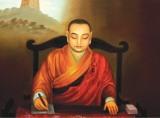Archives
THE ANCIENT SILK ROUTE IN RETROSPECT
Her observation finally turned into a unique idea of rearing silkworms at her home, in which she was successful. The clever Lady could immediately understand that threads thus collected from silk-rearing would make wonderful yarn. Later, she also invented looms to weave fabrics from the threads which were produced by the cocoons.
Over the years, this silk rearing started by the Empress at her home became a household task of every woman in China, flourished and constituted the most precious item of the ancient trade and commerce of China. During the period of the Han dynasty, which ruled over China during 202 BC - 220 AD, the trade spread like wildfire and silk became one of the most precious and sought after items among various trade-items ranging from gold, precious stones and ivory to plant and animal species etc.
 The commercial routes used for trading equally played an enormous role in spreading ideas, thoughts and more particularly religion. The elements of Buddhism had traveled along with travelers and monks. Travelers including Fah-Hian (400 AD) and Zuan-Zhuang (Hiuen-Tsang in Indian terminology 700 AD) during the Tang dynasty made their unique travels and created unique literatures and historical anecdotes which are still considered as the most fundamental components of understanding societies of that period. Later, Marco Polo, a Venetian traveler, made his journey from the West to Eastern countries including China and India through this route during the 13th century.
The commercial routes used for trading equally played an enormous role in spreading ideas, thoughts and more particularly religion. The elements of Buddhism had traveled along with travelers and monks. Travelers including Fah-Hian (400 AD) and Zuan-Zhuang (Hiuen-Tsang in Indian terminology 700 AD) during the Tang dynasty made their unique travels and created unique literatures and historical anecdotes which are still considered as the most fundamental components of understanding societies of that period. Later, Marco Polo, a Venetian traveler, made his journey from the West to Eastern countries including China and India through this route during the 13th century.
The road gradually grew in volume and size with movement of traders and caravans which witnessed the growth of human habitations alongside it, establishing trade relations and connecting ancient Chinese, Indian, Persian, Arabian, ancient Greek and Roman cultures. The Northern Silk Routes extended up to Europe and Egypt while the lesser known Southern Silk Route connected countries like Myanmar (erstwhile Burma), India, Nepal, Bhutan, Bangladesh. The historic passage covering a length of around 7000 kilometers, however, had gone into prolonged hibernation, particularly with the development of more convenient and comparatively cheaper sea-routes for trade and commerce during the medieval period.
It can be surmised that though it was an exemplary innovation, Lady Hsi-Ling-Shih could hardly have imagined that one day an international passage having immense historical significance and connecting cultures and ideas of both the East and the West, would be named after Silk, and the idea of re-utilizing the passage would be relevant even after 5000 years, that is during the 21st century.
India’s North East region has always been serving as an integral part of this trade and commerce as well as the exchange of ideas- both in formal and informal ways. Some of these traditional routes are still alive even today but in informal ways, as most of the tribes and communities living in this remote part of India have actually drawn their origin to the Tibeto - Burmese group having traditional cultural and trade linkages with these societies.
 The North East and particularly almost all the tribes and communities of Assam traditionally have their unique expertise in silk - rearing since time immemorial. It is difficult to trace the origin of silk in this part of the world. However, the existence of traditional trade routes between ancient China and Assam has been established by ancient travelers and historical documents. Chang Kien, a Chinese explorer traces his country’s trade links with Assam as far back as 100 BC. According to the ‘Periplus of the Eastern Sea’, Assam silk like Muga and ‘Pat’ reached the kingdoms of Egypt and Rome and was as famous as Chinese silk and Tibetian Pasmina. The weavers of Pragjyotisha thus made their country wealthy through silk.
The North East and particularly almost all the tribes and communities of Assam traditionally have their unique expertise in silk - rearing since time immemorial. It is difficult to trace the origin of silk in this part of the world. However, the existence of traditional trade routes between ancient China and Assam has been established by ancient travelers and historical documents. Chang Kien, a Chinese explorer traces his country’s trade links with Assam as far back as 100 BC. According to the ‘Periplus of the Eastern Sea’, Assam silk like Muga and ‘Pat’ reached the kingdoms of Egypt and Rome and was as famous as Chinese silk and Tibetian Pasmina. The weavers of Pragjyotisha thus made their country wealthy through silk.
Documents reveal, in addition to silk, Assam was also famous for exporting aromatic wood, resins etc. to the rest of India. The best qualities of Sandal wood and Agar or aloe wood, used as incense and for perfumes have been found in the forests of the state since ancient times. Tejpat, used as a spice, which has been identified by the Ahoms and other writers as the malabothrum of the Greeks and of the Romans, was traded and exported from India from ancient times. This evergreen tree with its aromatic leaves is rare, found in the areas of the Indus to the Sutlej of India, but is common in Assam and Burma. From the account of ‘Periplus of the Eastern Sea’, it appears that this trade was carried through Assam. Black pepper or long pepper and Lac were two products of Assam forests. Assam was a large producer of shellac, which was exported to China and Japan to be used in the manufacturing of cabinets. The quality of this Lac was the best in the whole of Asia. Thus, Assam was a known name for silk and precious forest and mineral products which were transported to neighboring provinces as well as to countries like Tibet, Burma and China. The trade was mainly carried out using river transport. The route to China was by sea and also through the mountains to the north of Assam. The rich heritage of silk weaving found its space during the period of the Kirata Kings too. In 180 AD, Muga, silk fabrics were specially designed to make tunics for soldiers of the Kirata kings. To keep these warriors distinct in their identity, Muga silk fabrics were converted into a designed costume wrapper with brand names as Peetambari and Uttari. These fabrics were woven in a small river island named Suban - Kuchi, later identified as Sualkuchi - the present silk hub of Assam. During the 11th century, king Dharma Pala, who ruled over Kamrupa during the Pal dynasty, rehabilitated 26 families of weavers to settle in Sualkuchi village in Assam. However, Sualkuchi became the full - fledged weaving village during the Ahoms period of the medieval world. The Ahom kings gave Muga their royal patronage by designating Muga silk as royal fabric.
 Muga silk continued to play a major role in the economy of the state even during British rule. However, the direction of trade during the British period was towards Bengal only. According to Dr. Raju Phukan of Gargaon College, “Muga silk formed the staple trade of the East India Company during the middle of the 19th and the early 20th centuries. During 1832-33 (Dec-April), 1833-34 (May- June) & 1834-35 (July-June), Assam exported 69, 291 & 224 maunds respectively of muga silk thread to Bengal, the value of which was placed at Rs 13,973.00, Rs 58,220.00 & Rs 53,889.00 respectively. According to A.J.M. Mills, Goalpara, Sibsagar and Lakhimpur districts of Assam exported Muga raw silk to Bengal during the middle of the 19th century. The total value of export of Muga raw silk from Lakhimpur District during 1871-72 was about Rs 60,900.00. During 1882-83 & 1897-98, the total value of export of silk from Assam was Rs 2,04,930.00 & Rs 3,66,310.00 respectively. During 1890-91, 1900-01 and 1903-04, the total value of exported silk from Assam only through land routes was Rs 3,000.00, Rs 4, 000.00 and Rs 3, 000.00 respectively.” (Muga Silk Industry of Assam in Historical Perspectives, published in Global Journal of HUMAN SOCIAL SCIENCE, History & Anthropology Volume 12 Issue 9 Version 1.0 Year 2012)
Muga silk continued to play a major role in the economy of the state even during British rule. However, the direction of trade during the British period was towards Bengal only. According to Dr. Raju Phukan of Gargaon College, “Muga silk formed the staple trade of the East India Company during the middle of the 19th and the early 20th centuries. During 1832-33 (Dec-April), 1833-34 (May- June) & 1834-35 (July-June), Assam exported 69, 291 & 224 maunds respectively of muga silk thread to Bengal, the value of which was placed at Rs 13,973.00, Rs 58,220.00 & Rs 53,889.00 respectively. According to A.J.M. Mills, Goalpara, Sibsagar and Lakhimpur districts of Assam exported Muga raw silk to Bengal during the middle of the 19th century. The total value of export of Muga raw silk from Lakhimpur District during 1871-72 was about Rs 60,900.00. During 1882-83 & 1897-98, the total value of export of silk from Assam was Rs 2,04,930.00 & Rs 3,66,310.00 respectively. During 1890-91, 1900-01 and 1903-04, the total value of exported silk from Assam only through land routes was Rs 3,000.00, Rs 4, 000.00 and Rs 3, 000.00 respectively.” (Muga Silk Industry of Assam in Historical Perspectives, published in Global Journal of HUMAN SOCIAL SCIENCE, History & Anthropology Volume 12 Issue 9 Version 1.0 Year 2012)
Apart from mulberry silk, a large part of Eri silk yarn that constitute over 90 per cent of Assam’s total silk production, has been exported to countries like Nepal and Bhutan through the centuries, which is entirely an informal trade. Unlike Mulberry and Muga, Eri silk yarn which comparatively costs less, is used to produce warm clothes, which is highly useful in the hills. However, export of Muga silk, which is exclusive to Assam, has become completely absent from the external trade scenario of the state after independence. The state produces around 100 MTs of Muga silk per year, which is still below the requirement of the state’s consumption. The state also produces a considerable quantity of Mulberry silk. However, over 90 per cent of the state’s Mulberry silk yarn now comes from the Bangalore silk exchange. A considerable quantity of Tassar silk yarn, a comparatively low quality silk that bears resemblance to Muga, comes from outside. Consumption of Mulberry silk in Sualkuchi is around two lakhs kilograms a year. During August 2012, per kg mulberry silk for use as weft cost around Rs 4000/while the yarn used for warp was Rs 3500/ according to the silk - weavers of Sualkuchi.
India is the largest consumer of raw silk in the world with a total consumption of 28,733 tonnes during 2011-12. However the country’s domestic production during that year was 23,060 tonnes leaving a huge gap of 5,700 tonnes between demand and production which is imported mainly from China. India imported 3845 tonnes of raw mulberry silk worth Rs 952 crore from China, Japan, Korea, Uzbekistan Thailand and others between April and December 2012. Of this the import from China alone was to the tune of 3645 tonnes worth Rs 903 crore.
 Although raw silk constitutes one of the 20 notified items that can be imported from China through the Nathu - La Pass in Sikkim, the nearest point of the India - China international border trade for North East India, supply of raw silk to weavers in Assam and other north - eastern states is still dominated by the silk merchants of Bangalore.
Although raw silk constitutes one of the 20 notified items that can be imported from China through the Nathu - La Pass in Sikkim, the nearest point of the India - China international border trade for North East India, supply of raw silk to weavers in Assam and other north - eastern states is still dominated by the silk merchants of Bangalore.
Border trade through the Nathu - La Pass across India and China in Sikkim, an important part of the ancient Southern Silk Route was re-opened on July 6, 2006. However, the total volume of import from China through this trade point in 2012 was only to the tune of Rs 1.01 crore against the export from India to China through it to the tune of Rs 5.98 crore.
Supply of raw silk yarn from Bangalore to Assam involves the engagement of middlemen at various stages due to which cost of per kg raw silk becomes excessively high in the Assam market. With the price of raw silk sourced from Bangalore continuously showing an upward trend making it difficult for weavers in Assam to sustain and thereby finding weaving increasingly non-remunerative in the absence of a market to sell their products at higher costs, there is a likelihood of raw silk suppliers exploring the possibility of importing raw silk from China through the Nathu - La trade point in the near future to feed the traditional silk markets of Assam.

